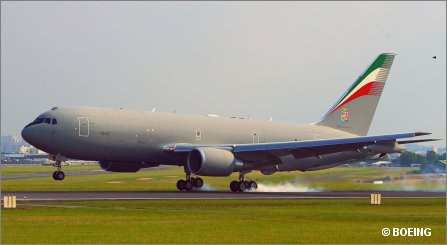Rand analysis of US Air Force requirement raises possibility of manufacturer competing against its own aircraft
Boeing may have to compete for a long-awaited US Air Force tanker contract not only against Airbus aircraft, but its own 777. The possibility that the USAF may require an aircraft larger than the KC-767 Boeing is preparing to offer is raised by a tanker analysis of alternatives (AoA) completed by Rand.
Reports say the still-classified AoA calls for the air force to acquire medium to large tankers converted from commercial airliners. “Those are two different entities,” says John Sams, Boeing vice-president, air force systems. A medium tanker would replace the Boeing KC-135, while a large aircraft would augment the USAF’s McDonnell Douglas KC-10 tanker/transport fleet. “Which one does the air force plan to recapitalise first?” he asks.

The USAF may require something bigger than the KC-767
Industry had not been briefed on the AoA results as of late last week, but anticipated the report’s completion would allow the USAF to release a request for information (RFI) within the next three months. This could lead to a request for proposals for the first tranche of tankers by year end, and contract award early in 2007 – although the AoA reportedly says there is no rush to replace the KC-135s.
Secretary of the air force Michael Wynne confirms the RFI may be released before March. The USAF needs to move “with deliberate speed” to ensure having the widest possible competition, and its budget is adequate to run the competition, launch production and possibly receive the first deliveries within the next five years, he adds.
The AoA is a boost to EADS North America and Northrop Grumman, prime contractor for the rival Airbus A330-based KC-30 tanker proposal. The KC-30 is already slightly bigger than the KC-767, capable of carrying more fuel and cargo, while the team could offer a derivative of the A340-500/600 to compete against the 777 for any large aircraft requirement.
Sams says the lighter KC-767 is better suited than the KC-30 to replace the KC-135 because of its lower fuel burn and runway loading and smaller parking footprint. The KC-767 can carry 19 cargo pallets, compared with six in the KC-135, but the KC-30 can carry 25, which may be a clincher if the air force opts for a tanker/transport.
Having already invested around $1 billion in the KC-767, Boeing is counting on the USAF putting the medium aircraft requirement first. The 777 Freighter, on which a tanker variant of the larger aircraft would be based, can carry 27 pallets on the main deck, plus 10 in the lower hold.
GRAHAM WARWICK / WASHINGTON
Source: Flight International
















